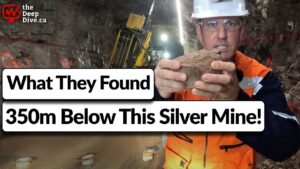Vancouver, B.C. – July 20, 2017: San Marco Resources Inc. (SMN: TSX-V) (“San Marco” or “the Company”) has increased the Chunibas HQ core drilling program from four to six holes following the discovery of an extensive, previously unknown, intrusive breccia associated with mineralization encountered during the current drill phase. Management considers this to be a very important discovery and is working on multiple fronts to ascertain how to best explore it and determine its economic significance.
Bob Willis, San Marcos CEO stated,
“It is very early days, but we don’t want to understate the potential significance of this discovery. It’s too early to classify this new discovery though it has affinities to both breccia-hosted and intrusive-hosted systems, which are host to some large gold and gold-copper discoveries worldwide made in the recent past.
“Our core drilling, the first on the property, allowed us to log long contiguous sections of rock unaffected by surface weathering, something unavailable to past workers. This led to the discovery of the new intrusive breccia in all holes drilled so far, extending from the top to the bottom of the holes in most cases. Subsequent prospecting confirmed the breccia extends at least 200 metres west and 300 metres south of the Hole 1 and Hole 4 areas and it remains wide open. The area will be remapped to determine the surface extent of the breccia but early indications from our widely spaced drill holes is that it is fairly large. While we need to understand zoning or other possible controls on gold emplacement, we are highly encouraged that all core containing breccia assayed to date exhibits at least anomalous (greater than 50 ppb) gold values. It will be exciting times as we work to define the magnitude of the system, refine and better understand the geological model and locate zones of mineralization with economic interest. San Marco is taking this discovery very seriously and shareholders should expect more reporting on it in coming weeks. “
As indicated in the Company’s News Release dated May 31, 2017, the primary objective of the current drill program was to confirm the presence of higher grade mineralization within narrow (1 – 2 metres wide) shear zones, and possibly low-grade mineralization in the flanking wall rock. Exploration by previous property owners consisted exclusively of surface work and RC drilling. They concluded the Chunibas system was of the low sulphidation, epithermal type with mineralized shears / veins hosted in a monzonite intrusion. The San Marco core-drilling program was designed to test three separate areas of old workings and presumed shearing along approximately 1,000 metres of north-south strike.
Upon commencement of drilling and logging of the core, it immediately became apparent that the dominant rock type in the drill core is a multi-lithic (breccia fragments of different compositions) highly altered, intrusive breccia, and NOT monzonite. Two holes (drilled to the east at – 60 degrees) around the southernmost workings intersected breccia from the collars to total depth (154 metres and 201 metres respectively). Additional holes completed to date have intersected breccia as well. Drilling has now been concluded, with approximately 860 metres completed in the six core holes, see map Chunibas Geology and Drill hole location July 20-17*, for locations of drill collars from the current program as well as historic drilling. Following are the results of three holes, one each in the three areas of old workings over 1000 metres of strike. Results of remaining holes will be released when all assays are received and analyzed.
Highlights are:
Hole CHD – 01 39.0 metres of 0.67 grams per tonne gold
- Including 20.0 metres of 1.05 grams per tonne gold, 2.15 metres of 1.97 grams per tonne gold and 1.0 metre of 4.55 grams per tonne gold
Hole CHD – 02 21.0 metres of 0.58 grams per tonne gold,
- Including 1 metre of 6.78 grams per tonne gold, 1.20 metres of 2.42 grams per tonne gold at the bottom of the hole (i.e. hole ended in mineralization)
Hole CHD – 03 3.3 metres of 5.05 grams per tonne gold. Hole ended in mineralization with the final 2.2 metres grading 1.05 g/t gold (a separate interval)
Note; Hole CHD-03 intersected primarily diorite host rock rather than breccia, thus gold mineralization is primarily restricted to the higher-grade shear zone.
Early interpretation of these results indicates discovery of a breccia body, which has a significant footprint horizontally and vertically. Although breccia was previously identified in isolated outcrops, it was not systematically mapped nor recognized as an important host rock to mineralization. Holes CHD 01 and CHD 02 also exhibit anomalous gold (0.12 – 0.14 g/t over 30 -35 metres, higher up in the drill hole) in core, which does not appear to contain structures, suggesting gold may be disseminated in the breccia. All gold intercepts so far received are consistent with historical Reverse Circulation drill hole assay grades. The current drill program confirms gold mineralization exists from surface to approximately 75 metres below surface, and is open to depth, and in all directions laterally.
Based on review of the drill core and potential size implications of the breccia body, the next exploration steps will include;
- Receipt of and plotting / compilation of all drill holes assays.
- Merger of historic data together with 2017 results to generate 3D Leapfrog model to create a solid basis for additional exploration.
- Remapping of the surface geology, with particular attention to the distribution and types of breccia.
- Continue petrographic studies with emphasis on host rock textures, character of hydrothermal alteration, and the distribution and controls to gold mineralization
- Remodelling of all surface geochemical data to investigate potential pathfinder elements better suited to delineate the footprint of the breccias and identify / vector towards areas with higher grade mineralization.
Follow up drilling is expected to be commenced once targeting based on the new model is completed. Please see table below for complete listing of significant assays from holes reported today.
| DH | From [m] | To [m] | Interval [m] | Au [g/t] |
|---|---|---|---|---|
| CHD-01 | 88.00 | 127.0 | 39.0 | 0.67 |
| Including | 93.0 | 113.0 | 20.0 | 1.05 |
| And | 93.85 | 96.0 | 2.15 | 1.97 |
| And | 111.0 | 112.0 | 1.0 | 4.55 |
| CHD-02 | 45.0 | 66.0 | 21.0 | 0.58 |
| Including | 51.0 | 52.0 | 1.0 | 1.01 |
| And | 60.0 | 61.0 | 1.0 | 6.78 |
| And | 109.0 | 110.2 | 1.2 | 2.42 (last sample at the end of the hole) |
| CHD-03 | 30.0 | 43.3 | 3.3 | 5.08 |
| Including | 40.0 | 42.0 | 2.0 | 6.74 |
| And | 118.0 | 120.2 | 2.2 | 1.05 (last sample at the end of the hole) |
| CHD-04 | – | – | – | Assays Pending |
| CHD-05 | – | – | – | Assays Pending |
| CHD-06 | – | – | – | Assays Pending |
All holes were drilled at – 60 degrees inclination and azimuths of CHD-01: 90 degrees; CHD-02: 305 degrees; and CHD-03: 90 degrees. True widths are presently unknown, as the discovery holes do not have enough information yet to identify where the holes are located in the mineralized system.
Assaying for this drill program is being done by ALS Chemex located in Vancouver, B.C. Sample preparation is done at the Chemex lab in Hermosillo, Mexico, pulps are then shipped to Vancouver for analysis. Prepared samples are analyzed for gold by the Au – ICP21 method and multi-elements by ME – MS61, preparation 31B.
Drill core was sawn in half by a gas-powered diamond saw, then photographed and logged. One half of the core is sent for assay analysis and the other retained at the Company’s secure exploration facility in Sahuripa, Mexico.
The QA/QC program consists of submission of duplicate samples and insertion of certified reference material and blanks inserted at regular intervals. These are inserted every 10 samples, or 10% of the total. Samples are bagged and tagged at the Company’s core facility in Sahuripa, Mexico and held in a secure environment, until picked up by ground transport of ALS Chemex.
About San Marco
San Marco Resources Inc. is a Canadian mineral exploration company with a portfolio of promising projects in mining-friendly Mexico, including the Chunibas, Mariana and 1068 Projects in Sonora State.
San Marco actively pursues strategic project generation program focused on high-caliber, low acquisition cost opportunities in the North-western Mexico. The Company has a committed management team with extensive experience in Mexico and a proven track record of building shareholder value.
San Marco currently has 56,051,832 issued and outstanding shares.
On behalf of the Board of Directors,
Robert Willis, P. Eng.
President & CEO
For further information, contact:
Nancy Curry
info@sanmarcocorp.com
National Instrument 43-101 Disclosure
This news release has been approved by San Marco’s CEO, Robert D. Willis, P. Eng. a “Qualified Person” as defined in National Instrument 43-101,Standards of Disclosure for Mineral Projects of the Canadian Securities Administrators. He has verified the data disclosed, including sampling, analytical and test data, underlying such technical information by reviewing the assay reports provided to San Marco by its independent testing laboratory.
San Marco has implemented quality assurance (“QA”) and quality control (“QC”) programs to ensure sampling and analysis of all exploration work is conducted in accordance with the best possible practices. All sampling programs are carried out in a careful and diligent manner using scientifically established sampling practices designed and tested to ensure that the results are representative and reliable. Quality control programs appropriate to the type of sample and the mineralization are implemented, including such measures as external blanks, standards and duplicate samples. The security of samples from sample acquisition to analysis is a vital component of the sampling process. Procedures include the use of secure core logging, sampling, storage and preparation facilities as appropriate and the prompt, secure and direct shipping of samples to the laboratories. Appropriate sample security procedures are employed given the geographic and topographic conditions and the logistics created by the site location.
Forward Looking Information
Information set forth in this document may include forward-looking statements. While these statements reflect management’s current plans, projections and intents, by their nature, forward-looking statements are subject to numerous risks and uncertainties, some of which are beyond the control of San Marco. Readers are cautioned that the assumptions used in the preparation of such information, although considered reasonable at the time of preparation, may prove to be imprecise and, as such, undue reliance should not be placed on these forward-looking statements. San Marco’s actual results, programs, activities and financial position could differ materially from those expressed in or implied by these forward-looking statements.
Neither the TSX Venture Exchange nor the Investment Industry Regulatory Organization of Canada accepts responsibility for the adequacy or accuracy of this release.
Original Article: https://www.sanmarcocorp.com/news/2017/chunibas-drill-program-expanded-after-discovery-of-large-intrusive-breccia-system/

















